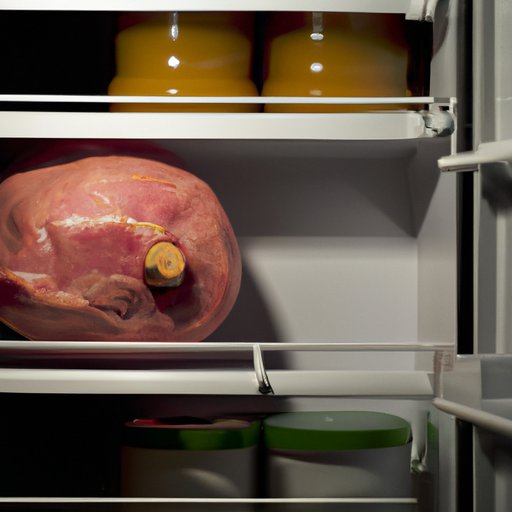Introduction
Ham is a cured meat product made from pork that has been smoked or salted. It can be purchased pre-cooked, semi-cooked, or raw. Refrigeration is essential for keeping ham fresh and safe to eat. How long does ham last in the refrigerator? This article will explore the shelf life of refrigerated ham, along with tips for storing it properly.
A Guide to Refrigerating Ham: How Long Does it Last?
The shelf life of ham depends on several factors, including how it was processed, the type of packaging it came in, and how it is stored. Generally speaking, cooked ham will last up to five days in the refrigerator, while uncooked ham can last up to two weeks.
Factors That Affect Shelf Life
The shelf life of ham is affected by several factors. The type of ham, whether it is cooked or uncooked, plays a role in how long it will remain fresh. Cured hams, such as country hams, have a longer shelf life than uncured hams. The type of packaging also affects the shelf life. Vacuum sealed packages are best for maintaining freshness, while plastic wrap is not as effective. Finally, the temperature of the refrigerator can impact the shelf life of ham.

Average Shelf Life of Refrigerated Ham
Cooked ham typically lasts up to five days in the refrigerator. Uncooked ham, like country ham, can last up to two weeks if stored properly. Ham that has been frozen can last up to three months. It is important to note that all dates are approximate and may vary depending on the type of ham and how it is stored.
What Is the Recommended Storage Time?
The recommended storage time for refrigerated ham is three to five days for cooked ham and two weeks for uncooked ham. It is important to follow these guidelines to ensure the safety and quality of the meat. Frozen ham should be consumed within three months.

Signs That Ham Has Gone Bad
It is important to be aware of the signs that ham has gone bad. If the ham has a sour smell, slimy texture, or discoloration, it should not be eaten. Additionally, if the ham has been stored for longer than the recommended time, it should be discarded.

Tips for Storing Ham in the Refrigerator
There are several steps you can take to ensure that your ham stays fresh and safe to eat. Wrapping and sealing ham in plastic wrap or aluminum foil helps keep out air and moisture. Choosing an appropriate container, such as a shallow dish or airtight container, is also important. Be sure to store the ham in the coldest part of the refrigerator, usually the back or bottom shelf.
How to Maximize the Shelf Life of Ham
To maximize the shelf life of ham, it is important to keep it covered and away from other food items. Unused portions should be frozen as soon as possible. Leftovers should be eaten within four days. It is also important to avoid cross-contamination when handling raw and cooked meats.

Keeping Ham Fresh: What You Need to Know
When storing ham, it is important to keep raw and cooked meats separate. Raw ham should be stored in a sealed container or wrapped in plastic wrap or aluminum foil. Cooked ham should be stored in an airtight container or shallow dish. Both should be stored in the coldest part of the refrigerator.
How to Make Sure Your Ham is Safe to Eat
Before consuming any ham, it is important to check the expiration date. When purchasing pre-packaged ham, be sure to check the use-by date. It is also important to keep track of how long the ham has been in the refrigerator. Discard any ham that has been stored for longer than the recommended time.
How to Store Ham for Optimal Freshness and Longevity
The best way to store ham is to purchase vacuum sealed packages. These packages help maintain freshness and keep out air and moisture. For maximum freshness, it is important to defrost ham before cooking. Reheating leftovers should be done quickly and thoroughly, as reheated ham can spoil quickly.
Conclusion
Refrigerating ham is essential for preserving its freshness and extending its shelf life. The shelf life of ham depends on several factors, including how it was processed, the type of packaging it came in, and how it is stored. Generally speaking, cooked ham will last up to five days in the refrigerator, while uncooked ham can last up to two weeks. It is important to follow proper storage guidelines and safety measures to ensure optimal freshness and longevity.


